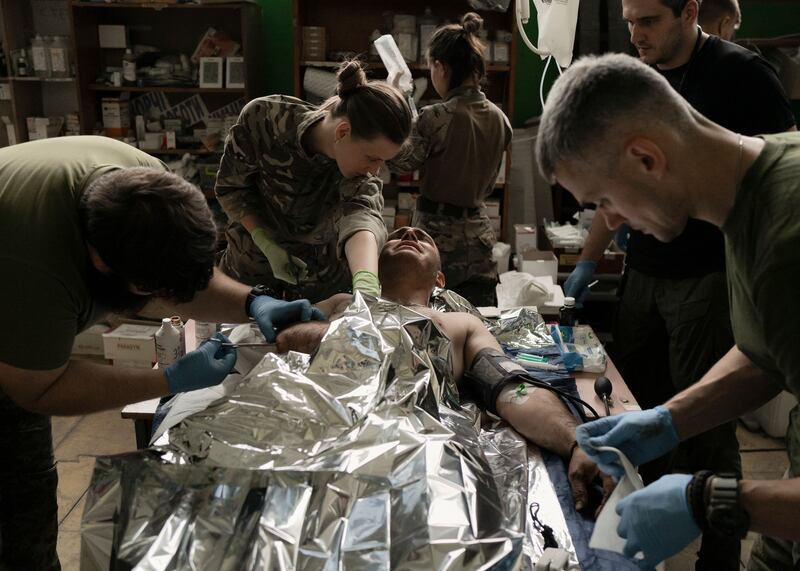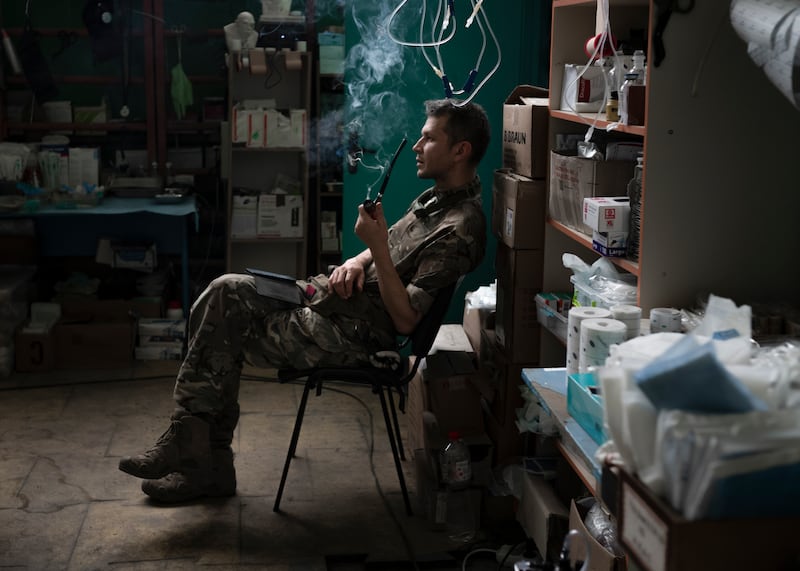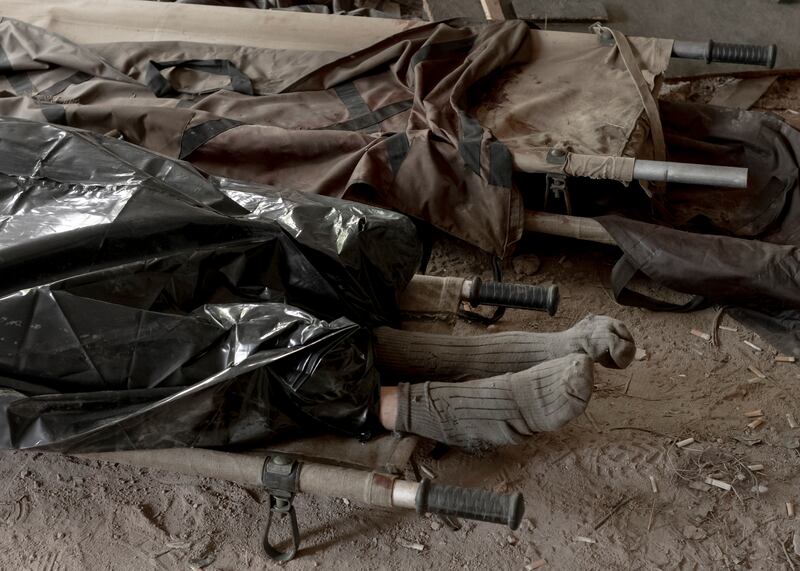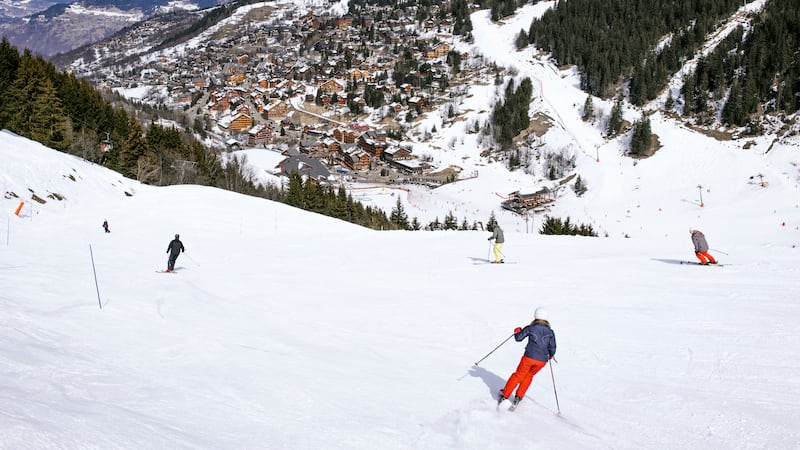A commotion sounded at the entrance of the building, and a shout went up. Soldiers carried in two men on stretchers, one with his lined face taut in a grimace, a third, with bloodstained pants, following behind.
Within seconds the men were lifted on to operating tables and medics swarmed in, cutting off bloody clothes, hooking up drips, talking to the men in low voices.
“Brother, you will make it,” the third soldier, Batya, called out to his friend with a chest wound. “Hold on, we have more to do.”
Wounded just 40 minutes earlier on Ukraine’s southern front in the Zaporizhzhia region, the soldiers from the 110th Brigade had arrived at a stabilisation point, one of a dozen medical stations set up by the Ukrainian army within a few kilometres of the front line to provide critical, lifesaving care.
RM Block
For the past two months, as Ukrainian troops have tried to break through Russian defences in a broad counteroffensive to seize back occupied terrain in southern Ukraine, their units have run into dense minefields and heavy Russian artillery fire and drone attacks.
Each kilometre is a bloody fight as the counteroffensive has progressed painfully slowly, with units coming up against dug-in Russian defences and taking heavy casualties. Troops spearheading the offensive have breached the first line of defence in areas in recent days, potentially opening the way for a deeper assault.

Positioned close to the front lines, the stabilisation points, temporary medical posts where patients are stabilised for onward evacuation, have been receiving a constant inflow of soldiers wounded in the fighting. The numbers have been “colossal”, said a medic from the centre where the three men from the 110th Brigade were treated.
Equipped with four operating tables in a long room, the stabilisation point handles the wounded from several brigades involved in the counteroffensive and has been working around the clock for two months.
The Ukrainian military allowed journalists from the New York Times to visit several stabilisation points along 160km of the southern front over the past week. For security reasons, they were asked not to identify locations or buildings, and to name soldiers only by their call signs.
As Ukraine prepared new brigades for the counteroffensive, it also set up an extensive medical evacuation system with four lines of care, encompassing 20 city hospitals in the region, an array of stabilisation points and up to 50 medical units attached to the brigades.
The man who devised the system, Dr Roman Kuziv, the head of the military hospital in the city of Zaporizhzhia, flicked open a screen on his mobile phone to show a database of the case load across the whole Zaporizhzhia front. The patients are colour-coded according to the severity of their wounds.
“I can see if they are yellow, green or red,” he said. The system was running at 20 per cent of its capacity, he said.
The aim is to ensure that each wounded soldier receives a high level of care within as little as 25 minutes of the injury in order to save lives, he said. It is not always possible. A combat medic on the front line quickly administers first aid, but Russian artillery fire is often so intense that sometimes units cannot evacuate the wounded for hours, medics said.
The ambulances that transport soldiers to the stabilisation points frequently come under fire as well, and soldiers sometimes have to drag or carry the wounded for several kilometres on foot to a vehicle. A stabilisation point was hit in a missile strike one recent night, doctors said.
Despite the chaos of war, the system holds together well.

Stabilisation points are set back a few kilometres from the front line for safety and for access to a steady water supply. There, doctors treat the wounded for shock and to prevent blood loss before sending patients on to better equipped stabilisation points where surgeons can operate or to city hospitals, doctors said.
At the next medical stage, 40 minutes’ drive away on a potholed road, surgeons pinned broken limbs and fought to save a soldier’s foot from a mine injury. The bones were smashed, but the blood vessels were intact, said Bohdan, the doctor in charge. As the surgeons operated, he moved to a nearby table, pressing a pad on the bleeding wound of a soldier.
For operations near the front line, artillery barrages landed not far away as medical personnel, drivers and guards worked night and day. The staff stayed undercover most of the time to keep out of sight of Russian reconnaissance drones. At night, they worked in the dark for security, mostly using a red light, which is less detectable, on their headlamps.
The casualties arrived in spurts and on some days in a continuous rush. There were dozens of mine injuries and shrapnel wounds, but in this counteroffensive, few bullet wounds, doctors said.
A combat medic, pouring with sweat after carrying the wounded out from their positions, paced the room anxiously as doctors worked on the men, before heading back to the front line.
“Around 10 rockets from a grenade launcher landed nearby,” the soldier, Batya (51) said, describing the attack on their position. Still reeling from a concussion, he said he had grabbed a medical kit and run out to help the wounded. He came across the first wounded soldier, Vorchun (Grumpy), in the nearest bunker and bandaged his face and hands, and then found his friend Shuravi (57), who had been dragged into a trench with a chest injury, he said.
“He was probably in the open when he was hit,” Batya said, slumping in a chair, his head in his hands.
The three men from the 110th Brigade would survive, said Romashka, a quiet, calm officer who heads the stabilisation point. Romashka, whose call sign means Daisy, called the next medical post: “I’m sending you six guys, two yellow, the rest green.”

The next day, the 110th Brigade took part in an assault, taking heavy casualties. At night, all four tables were occupied by soldiers with severe leg injuries that would need amputation, said a Swedish volunteer combat medic, who asked that his name not be published for security reasons. The next morning, soldiers carried out body parts in black bags for disposal.
Some doctors said they had seen worse casualties in battles last year; one said they were treating up to 250 people a day back then in the counteroffensive in the Kherson region. The Ukrainian government does not release casualty numbers for the Ukrainian military, but Western officials have said the number of dead and wounded is more than 100,000.
In the first months after the Russian invasion last year, many soldiers did not have body armour or helmets and often suffered lethal injuries to the head and chest, said Dr Andrii Komarinets, the head of medical services for the 110th Brigade, who runs one of the larger stabilisation points.

Everyone has body armour now, he said, but the new threat is Russian mines.
“They booby-trap their dead, they booby-trap our dead, they mine anything they can,” he said of the Russian forces. “Our men enter a bunker, and they detonate it remotely. They have plenty of explosives.”
His teams were taking casualties, too, he said.
“We have a driver, his son died three days ago under shellfire on the battlefield,” he said. “And last week one of our combat medics died.”
The medic, call sign Boroda, was driving a medical evacuation car, clearly marked to indicate that it was an ambulance, when it came under direct fire from a Russian tank, he said.
The Russians had mined the wrecked vehicle and had it in their sights, so his team had not been able to retrieve it, he said.
The medics relied on donations, largely from the Ukrainian diaspora around the world, for additional equipment.
“The ultrasound machine was bought for us by Ukrainians living in Australia. We have an ambulance bought by Americans and delivered through the Ukrainian Church,” he said. “We have two mattresses from two guys in the Netherlands whom I have never seen.”
But the army was short of doctors and especially of nurses, he said.
“We don’t have enough hands,” he said.
The strain on the medical operations was often revealed in gestures rather than words. An administrator silently lifted a thick stack of medical reports from the past week, one for each patient. They had treated more than 70 people that day, and more were on their way, he said.
Romashka smoked an elegantly curved pipe as he scrolled through messages on his mobile phone while waiting for the next patients. In another corner of the room, nurses cut up a watermelon.
“Have some, it’s very sweet,” one said.
– This article originally appeared in The New York Times.

2023 The New York Times Company


















